UPDATE: I am starting to update this page with VNX2 (Code Name Rockies) Information. I have only uploaded the components sheet so far, but when I get time to do the others I will update them as well.
I find that many times when I’m talking to customers they are not sure what all makes up a VNX array, and this can complicate troubleshooting over the phone as well as cause confusion on both sides. To help clarify things I have created a series of quick reference sheets showing the components and what they are called. I have also created a couple of sheets that show what cables are involved in the VNX system and where they go. Stay tuned for VNXe sheets.
For the official VNX Spec sheet head over to EMC’s website.
Quick Reference Sheets
| Thumbnail | Title | PDF Link | PNG Link |
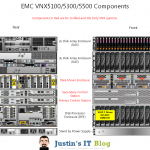 |
VNX 5100/5300/5500 Components | PNG | |
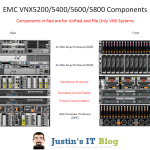 |
VNX 5200/5400/5600/5800/7600 Components | PNG | |
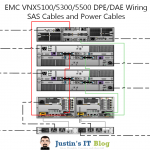 |
VNX 5100/5300/5500 SAS and Power Cables
I also did a quick how to video for doing these cables |
PNG | |
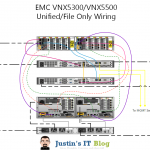 |
VNX 5300/5500 Unified/File Cables | PNG | |
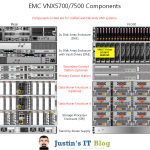 |
VNX 5700/7500 Components (also the VNX 8000 uses the same general layout) |
PNG | |
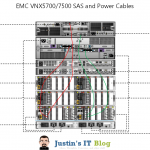 |
VNX 5700/7500 SAS and Power Cables | PNG | |
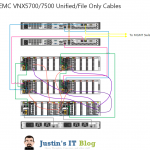 |
VNX 5700/7500 Unified/File Cables | PNG |
Components and their purpose
Standby Power Supply – SPS – This is a 1u uninterruptible power supply designed to hold the Storage processors during a power failure for long enough to write any data in volatile memory to disk.
Disk Processor Enclosure – DPE (VNX5100/5300/5500/5200/5400/5600/5800/7600 models) – This is the enclosure that contains the storage processors as well as the Vault Drives and a few other drives. It contains all connections related to block level storage protocols including Fiber Channel and iSCSI.
Storage Processor Enclosure – SPE (VNX5700/7500/8000 models) – This is the enclose that contains the storage processors on the larger VNX models. It is in place of the DPE mentioned above.
Storage Processor – SP – Usually followed by “A” or “B” to denote if which one it is, all VNX systems have 2 storage processors. It is the job of the storage processor to retrieve data from the disk when asked, and to write data to disk when asked. It also handles all RAID operations as well as Read and Write caching. iSCSI and additional Fiber Channel ports are added to the SP’s using UltraFlex modules.
UltraFlex I/O Modules – These are basically PCIe Cards that have been modified for use in a VNX system. They are fitted into a metal enclosure that is then inserted into the back of the Storage Processors or Data Movers, depending on if it is for Block or File use.
Control Station – CS – Normally preceded by “Primary” or “Secondary” as there are at least 1, but most often 2 control stations per VNX system. It is the job of the control station to handle management of the File or Unified components in a VNX system. Block only VNX arrays do not utilize a control station. However in a Unified or File only system the Control stations run Unisphere and pass any and all management traffic to the rest of the array components.
Data Mover Enclosure – Blade Enclosure – This enclosure houses the data movers for file and unified VNX arrays.
Data Movers – X-Blades – DM – Data movers (aka X-Blades) connect to the storage processors over dedicated fiber channel cables and provide File (NFS, pNFS, and CIFS) access to clients. Think of a data mover like a linux system which has SCSI drives in it, it then takes those drives and formats them with a file system and presents them out one or more protocols for client machines to access.
Disk Array Enclosure – DAE – DAE’s come in several different flavors, 2 of which are depicted in the quick reference sheet. One is a 3u – 15 disk enclosure which holds 15 – 3.5″ disk drives; the second is a 2u – 25 disk enclosure which holds 25 – 2.5″ disk drives; and finally the third is a 4u – 60 disk enclosure which holds 60 – 3.5″ drives in a pull out cabinet style enclosure. The third type is the more rare and are not normally used unless rack space is at a premium.
Maximum drives per System
I plan to update this article soon with the latest information, but I have noticed a LOT of traffic to this page so I thought I would include a quick contact form in case you have more questions or if you just need something clarified here. I think I may start doing this on some of my posts just because I don’t get emails that comments are waiting for me to approve or review. So hopefully this will speed up my ability to respond to any questions you may have.
Have a question or need more info? Let me know.
[mauticform id=”2″]
![]()



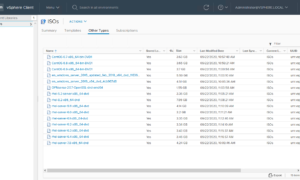
I keep coming to this blog post, it’s an amazing reference for the VNX HW.
Thanks for the share.
Pingback: EMC isilon VNX | ivannexus
Hi Justin,
I have a question, I have initialized new VNX 5200 array by Navisphere initialization wizard, but I should use Unisphere initialization vizard, and question is: is there any difference ?
thank you.
Pingback: The Anatomy Of EMC: DAE, DPE, SPE, And More – Server Mania Blog
Pingback: Anatomy of the Cisco UCS Mini - Justin's IT Blog | Justin's IT Blog
We received a VNX 5300 as a donation in our school district. It has 84 disks, a DPE, but no CS, six 3u DAE, and a standby power supply. How do we obtain access and manage it not knowing the IP address, passwords, or other information? Any guidance or advice would be appreciated. Thank you.
Hey Ken, I’d be happy help you get it running.
Shoot me an email and we will setup a time to touch base and get a plan in place.
My email is [email protected]
Hi Justin,
Trying to find out if the 2U, 25 (2.5-inch) DAE for VNX 51000, part V2-DAE-N-25-A (25 x 2.5 IN 2U DAE FIELD INSTALL) includes the SAS cables to connect to DPE or shoul I have to order the cables separately.
I appreciate your help on this, since I can´t find documentation on what is included in this V2-DAE-N-25-A
Thanks!
I’ve always had two sas cables included with the shelf. If you don’t get any let me know. I’ll mail you a pair as I have a bunch of extras.
We work for a data wiping company and we have an EMC VNX5300 DPE without any HDD’s, would these units have any residual data left on them if they do not contain hard drives? Thanks for any help.
A DPE is a lot like a computer. Without disks the only memory in it is ram and the bios. So you should be good to go. If your looking to dispose of it, I’ll gladly pay shipping costs… can always use a lab upgrade.
Thanks for sharing! This information helped us a lot when we were trying to start up an old VNX 5300. Regards from Perú
I have Qty-4 EMC VXN7500 arrays with Xeon based controller and 4or .5 disk shelfs in cabinets, I would like to sell them for $1000.00 each any takers?? Steve in Virginia [email protected]
Hey Steve, Any information on what disks are in the shelves? or have they all been removed?
Hi,
I have to replace memory on vnx5200 but it seems that it is placed in the chassis, on the motherboard and not on ultraflex modules, is it right?
Thank you for this VNX file which helped me a lot!